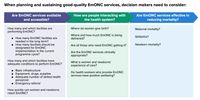Introduction to the EmONC Framework
What is the EmONC Framework?
The term “EmONC Framework” includes:
- A set of obstetric and neonatal signal functions
- Levels of EmONC (Basic, Comprehensive and Intensive EmONC)
- Indicators grouped into three domains (structure, process, outcome)
Purpose and users of the EmONC Framework
Using these components, the EmONC Framework provides an approach to planning and monitoring the EmONC system using facilities as the primary unit of analysis. It centers on the actual performance of facilities, and the status of the facility conditions most critical for optimal functioning. Use of the Framework provides a systems-level view of how EmONC is functioning, raising red flags on critical problems that might then require additional investigation to understand and address.
The EmONC Framework has been developed as a “people-centered” framework, incorporating perspectives of women using maternity services and health providers who are responsible for delivering EmONC. But the EmONC Framework’s primary users are ministry of health staff at the national and sub-national levels and their implementation partners, who are responsible for ensuring that health systems are well-functioning. These are individuals who will make decisions, plan, manage, monitor, and evaluate maternal and newborn health policies and programs (in this Guide we refer to them as “planners and managers” or “decision makers”). There are others who will also find the EmONC Framework useful in their work, including: advocacy and accountability non-governmental and community-based organizations, health facility community advisory boards, community leaders, and researchers.
The EmONC Framework of signal functions, levels of EmONC and indicators described in this Guide helps planners and managers to assess their system and envision its future by considering a series of questions. Together, the answers to these questions create a storyline (Figure 1) or narrative about the functioning of EmONC.
Figure 1: EmONC Framework storyline

The Framework maintains a tight focus on EmONC and is meant to be used in conjunction with multiple other tools and approaches for improving services. Indeed, there are many tools providing guidance for clinicians treating patients, managers leading quality improvement exercises, trainers designing curricula, senior health professionals conducting supportive supervision and mentorship, administrators strengthening supply chains, and information technology specialists strengthening data systems. We provide linkages to many of them throughout the Guide. All will be needed in any initiative to implement a comprehensive and ambitious strategy to strengthen maternal and newborn health services and reduce mortality.
But the EmONC Framework and Guide play a distinctly different purpose. They are designed for planners and managers at the national and sub-national level to engage in an assessment-planning-monitoring cycle with elements unique to implementation of EmONC.
The core challenge for planners is prioritization, deciding which facilities should be appropriately staffed, equipped and supported to deliver EmONC in the short-, medium- and long-term with the ultimate goal of phasing to scale. This can be a complex task given the specific medical interventions required to manage obstetric and newborn complications, the emergency time factor of EmONC services, the topography and road infrastructure of the country, the population density and diversity, historic patterns of inequity, and the cultural norms and practical concerns that guide women’s choices in childbirth.
Even once such prioritization is systematically done, an excellent EmONC plan on paper always confronts the reality of implementation in a complex health system. And so the second purpose of the EmONC Framework and Guide is monitoring, regular re-assessment and responsive action, in an iterative cycle.
This Guide is meant to be a living document in an evolving field. The digital version of the Guide will be updated as new norms and guidelines are developed.